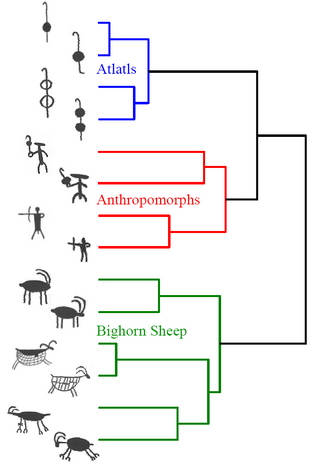 |
Welcome to the UCR Computational
Anthropology Site
This page is designed to report progress on our NSF
funded project: Tools to Mine and Index Trajectories of Physical
Artifacts. IIS Division of Information & Intelligent Systems
0803410 (2008-11). We gratefully acknowledge the financial support
of NSF, and the moral support of our program director. |
 |
The PI is Eamonn Keogh, the
Co-PI's are Vassilis Tsotras,
(UCR
CS) and Sang-Hee Lee (UCR
Anthropology)
Our proposals abstract:
The project proposes to develop computational methods and tools for
the discovery of spatio-temporal patterns in the distribution and historical
development of physical artifacts important to anthropology including the
development of a shape recognition system that allows researchers to compare
numerous projectile points and petroglyphs according to several criteria.
This will involve creation of a set of definitions/ data
representations/predicates/algorithms and intuitive and usable software
tools to enable the study of the spatio-temporal spread of physical objects.
The proposal uses innovative technology to apply to questions central to
archaeology. but which also has broad applicability to research in other,
diverse domains.
Publications:
Directly Related:
- Qiang Zhu and Eamonn Keogh (2010) Using CAPTCHAs to Index Cultural
Artifacts. The Ninth International Symposium on Intelligent Data
Analysis. (IDA)
- Xiaoyue Wang, Lexiang Ye, Eamonn Keogh and Christian Shelton.
Annotating Historical Archives of Images (2009). International Journal of
Digital Library Systems (IJDLS).
- Lexiang Ye and Eamonn Keogh (2009) Time Series Shapelets: A New
Primitive for Data Mining. SIGKDD 2009
- Qiang Zhu, Xiaoyue Wang, Eamonn Keogh, Sang-Hee Lee (2009).
Augmenting the Generalized Hough Transform to Enable the Mining of
Petroglyphs. SIGKDD 2009
- Qiang Zhu, Xiaoyue Wang, Taryn Rampley, Eamonn Keogh and Sang-Hee
Lee (2009) Towards Indexing and Data Mining all the Worlds Rock Art. In
the 37th Annual International Conference on Computer Applications and
Quantitative Methods in Archeology (CAA
2009)
- Taryn Rampley, Eamonn Keogh, Lexiang Ye and Sang-Hee Le (2009)
Automatic Construction of Typologies for Massive Collections of
Projectile Points and other Cultural Artifacts. In the 37th Annual
International Conference on Computer Applications and Quantitative
Methods in Archeology (CAA 2009)
- Rampley, Taryn T., Sang-Hee Lee, Lexiang Ye, and Eamonn Keogh (2010)
The Spread of Clovis: the application of shape similarity indexing to
understanding population dynamics. Paper presented at the 75th
Anniversary Meeting of the Society for American Archaeology. St. Louis,
Missouri. April 14 - 18, 2010
Indirectly Related: These are publications funded by
the grant, which are not directly on computational anthropology but are one
either spin-off technologies or enabling technologies that can be applied to
anthropology.
- Abdullah Mueen, Eamonn Keogh, Qiang Zhu, Sydney Cash,
Brandon Westover. Exact Discovery of Time Series Motifs. SIAM
International Conference on Data Mining, 2009. (We are using the MK
motif discovery algorithm invented here to find motifs in petroglyphs)
- Abdullah Mueen, Eamonn Keogh and Nima Bigdely-Shamlo
(2009). Finding Time Series Motifs in Disk-Resident Data. ICDM 2009.
Tutorials:
Directly Related:
- Eamonn Keogh: Mining Massive Collections of Shapes and Time Series:
With Case Studies in Anthropology. ACISS’09. 1 December. Melbourne,
Australia
Indirectly Related: These are tutorials funded by
the grant, but are not directly on computational anthropology but are part
of our broader outreach and service..
- Eamonn Keogh: How to do good research, get it published in
SIGKDD and get it cited! SIGKDD
2009. This tutorial does use examples from this
grant, in the (15-slide) section on the importance of testing on real
data.
- Eamonn Keogh: How to do good database/data mining research,
and get it published! ACISS’09. 30 November. Melbourne, Australia
Data:
We plan to release all our data, in general the data will be made
available within 6-months of being used in a publication. However if you
have a pressing need, just ask.
-
African Projectile Points: This dataset
consists of images of 186 points, about 4000 to 6000 years old, found in
Sahara Desert. We can send you the data on a free CD-Rom. In addition,
the physical objects are in our personal collection, so we can arrange
for you to examine them in person (just ask). Leaf shape;
serrated edge: 44 objects. Lanceolate to triangular; square to
contracting stem: 77 objects. Triangular; concave base to basal
notching: 21 objects. Triangular; barbed: 14 objects. Class Misc - this
was a miscellaneous group: 30 objects.
Notes:
- Can human computation meaningfully extract data from petroglyph
images? Here is a simply sanity
check.
Funded Students: To date, the following students have been
partly or fully funded by this grant.
- Lexiang Ye (Ph.d
ongoing)
- Abdullah Mueen (Ph.d
ongoing)
- Qiang Zhu (Ph.d
ongoing)
- Taryn T. Rampley
(Ph.d in Anthropology, ongoing)
- Huseyin Hakkoymaz
(Ph.d ongoing)
Part Time
- Alyssa Mclellan (Undergrad CS: image processing)
- Aaron Russo
(Undergrad CS: image processing)
- Giulia Katherine Hoffmann (Grad English dept: Technical communications)
Data Donors: To date, the following people have donated data:
- Evelyn Billo and Dr. Robert Billo of
Rupestrian CyberServices
- Dr. Michael R. Waters, Director of the
Center for the Study of the
First Americans, Professor of Anthropology and Geography, Texas A&M
University.

